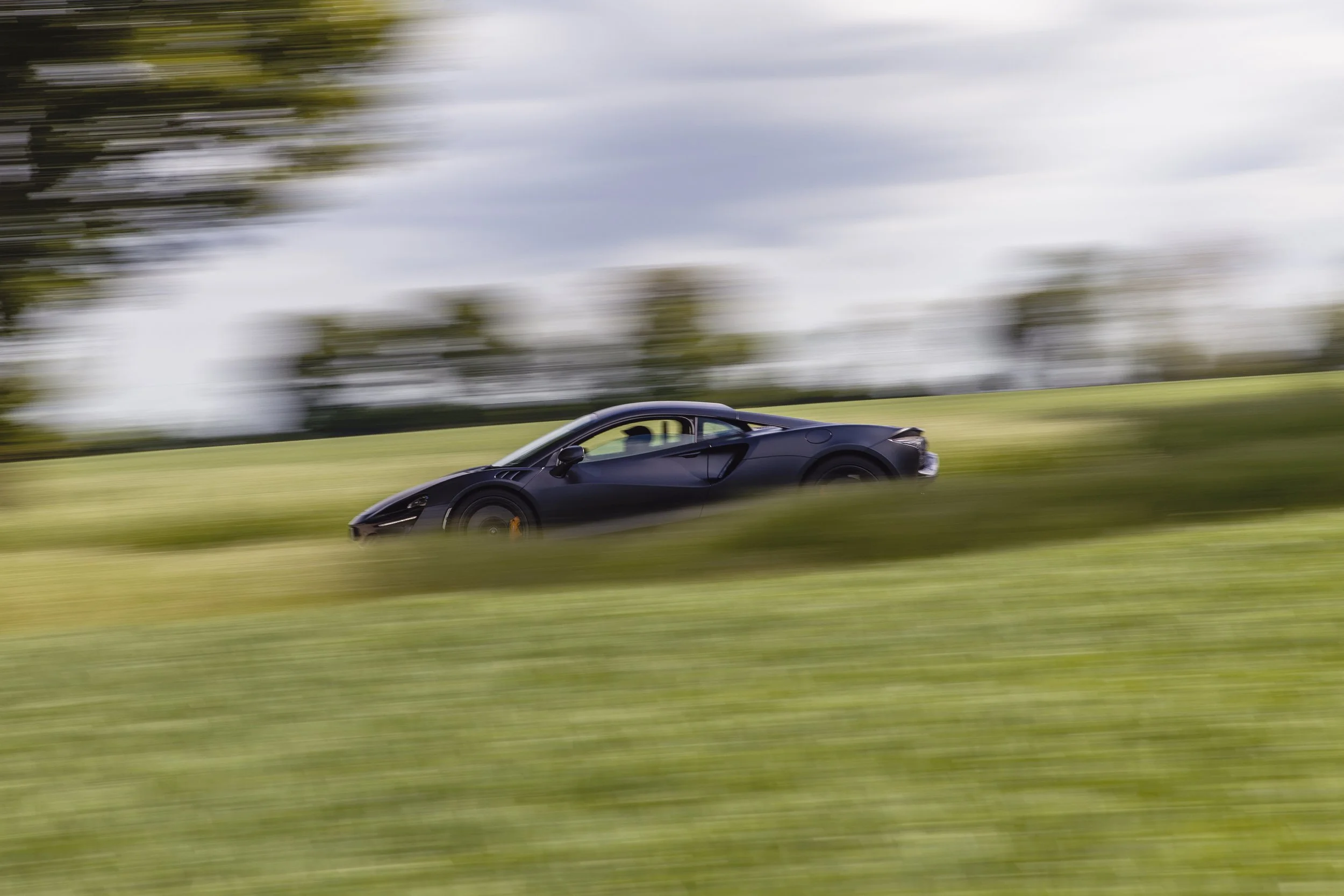ROAD TEST: McLaren Artura.
Following on from our first drive of the all-new McLaren Artura, we spend four days behind the wheel to see what it’s like to live with Woking’s high-performance hybrid.
PHOTOS: Dom Ginn
In the previous issue of Redline, we conducted our first drive of the new McLaren Artura. It consisted of a quick trip to the McLaren Technology Centre with some other journalists to collect a car, and grab some images along with a couple of hours of seat time. While it offered a good opportunity to develop a baseline understanding of Woking’s all-new high-performance hybrid, it wasn’t sufficient for conducting a thorough road test, especially when you consider how complex the car and its powertrain is. Fast forward a few months and we’re back with an Artura, but this time for four days of uninterrupted evaluation and a chance to see what it’s actually like to live with a hybrid supercar.
Usually when we spend time with a supercar we subject it to a good spanking, send it back to the manufacturer and then write about how it performed during that period. Daily use and liveability typically receive a passing mention, but given how new the production hybrid supercar concept is, it’s worthwhile focussing on how it impacts one’s daily experience with the vehicle.
The Artura is new from the ground up with very little carry over from other McLaren models. To those of you who keep calling it a facelifted 570S, please see yourselves out. We’ll get to the techy stuff in a moment, but it’s worth noting that the car is built round a new carbon composite tub which is optimised for the hybrid powertrain and has new aluminium subframes at each end. There’s a new E-differential which works with the multi-link rear suspension to improve traction and reduce understeer. The hydraulic steering has been recalibrated, the brakes have been borrowed from McLaren’s LT models and the wheels are wrapped in next-gen Pirelli P-Zero tyres. The twin-clutch gearbox is new and has eight speeds instead of seven, and the interior represents a significant departure from the McLaren cabins of recent years. At this stage, I’m going to take the opportunity to point out that the Artura is the best built McLaren I’ve tested. In terms of the exterior, the panel gaps are consistent, and inside the car the cabin is well put together – in other words, nothing was loose or flimsy.
From here on, McLaren could have gone down the easy path and dropped a non-hybrid V6 engine in to the chassis and put it on sale while citing gains in terms of fuel economy and reduced CO2 outputs, and it would have been job done. But instead, they opted for the long, drawn-out process of bringing a plug-in hybrid supercar to market, and one look at the powertrain specs will tell you all you need to know about how problematic a task that is. Getting an internal combustion engine and an electric motor which draws power from a separate battery, to talk to each other harmoniously is complicated. The E-motor has to successfully deploy and harvest electricity while supporting the ICE and it also needs to be able to decouple from the engine so it can run in EV-only mode. This requires hardcore thinking-power by lots of intelligent people to bring to fruition, however, when executed properly, the results are game changing.
The twin-turbo 3.0 litre V6 engine makes 577bhp and the E-motor which is powered by a 7.4kWh battery produces 94bhp. The combined outputs are 671bhp and 531lb ft. which give the Artura a 0-62mph time of 3.0 seconds, a 0-124mph sprint of 8.3 seconds and a top speed of 205mph. Entry-level supercar my a***!
Of course, if you’re familiar with McLarens then you’ll know that these kinds of performance figures are the norm, but the inclusion of the E-motor has fundamentally changed the way the Artura performs compared to other cars in the range. By far the most responsive McLaren I’ve driven, the Artura benefits not just from torque in-fill but some clever packaging which see the turbos mounted between the cylinder banks which brings improvements in response and performance. Gone is the momentary lag and slingshot effect of previous cars from Woking, and in its place is pin sharp throttle response and a linear power delivery. Peak power is now at 7,500rpm and the torque comes in from just 2,250rpm. This is the first McLaren I’ve driven that relishes the rev-limiter and can unlock performance without hesitation. And it’s fast. Viscously, frantically fast. In a straight line it’s more than a match for a Ferrari F8 Tributo which despite no longer being on sale, should be a class above the Artura.
However, the biggest gains brought by the E-motor come in the form of usability and economy, not necessarily the straight-line performance. By design, the car starts up in electric mode and the engine will only spring in to life once you apply enough throttle. On cold starts, the ICE needs time to warm up, so when it kicks in it will idle in the background while you zip around in EV mode, and once it engages you can then select your preferred gear and be on your way. The regen comes via a lift and coast system similar to the one found in a Formula One racing car, which means the battery never fully discharges and can be topped up on the move. This is something you have control of while driving, with options to use the available power for pure EV driving of up to 19 miles, to support the engine, or to top it up as you go about your business.
When I collected the car from Woking, I spent the following ninety minutes on the motorway where I ran the battery down. I averaged just over 30mpg which is frankly ridiculous when you consider the performance on offer. The only caveat is that if you wish to top the battery up while driving, you don’t get the same fuel economy because the focus is on regen not deployment. You can’t have your cake and eat it. When I encountered some traffic, I simply popped the Artura in to its electric mode which saved fuel, eradicated the stop-start engine drone and made it ironically the cleanest car in a traffic jam filled with normal, every day cars which are designed to be economical and kinder to the environment. A 3 Series driver even gawped in amazement when he noticed me switching from engine to E-motor.
If you leave the car in comfort, it will also switch over to electric only without you having to do it manually, but in sport and race, it will always leave the V6 running. The transition from engine to milk-float mode is generally smooth, although sometimes the change-over is accompanied by a small thud as mechanical bits disengage and the E-motor takes over. In time, I’m sure McLaren will smooth this out.
For the purpose of testing, we took the Artura to a Grid Serve charging station so we could plug it in. In the real world, this is probably something you’ll never need to do given the regen system and the fact you can plug it in at home. The Artura also does without fast charging because the battery is only small and it also helps save weight. McLaren reckons it can charge up to eighty per cent in just two and a half hours which is believable given our testing. Unless you’re embarking on a particularly long journey, this is a charge at night, regen during the day kind of hybrid, and you can drive free of range anxiety knowing that you’ll always have a glorious V6 engine which drinks this magical substance called petrol, to get you home. Just a thought… an Artura run on e-fuel would be a motoring and environmental wonder!
One of the main things I enjoyed though, was driving through a town or village using electric power and then turning the ICE back on once I hit a country road. McLaren may have created a car which is more sociable, drinks less fuel and puts out less nasty carbon dioxides, but it’s still a McLaren and therefore it’s a stunning driver’s car. Weight saving measures mean the Artura tips the scales at a little over 1,500kg with fluids, which has helped them retain all the driving dynamics we’ve come to expect. The recalibrated hydraulic steering which now has a touch more weight off-centre is full of feedback, the front end of the car is sharp, and there’s barely any body roll to speak of. It’s conventionally sprung with an anti-roll bar and is a touch more rigid than other McLaren road cars, but nevertheless, it soaks up lumps and bumps in the road and rarely becomes unsettled, even while deploying the full 671bhp through the rear wheels. The Artura is a car that breathes and flows down a country road, and the compact size helps you place it not just accurately – it feels like an extension of your inputs. And because the regen has been kept away from the brakes, the LT-spec carbon ceramics also have fantastic feel. The new E-diff also makes the Artura one of the more playful McLaren’s I’ve driven and it responds more positively to throttle adjustments mid-corner. The only area that really requires improvement is the gearbox. The new eight speeder doesn’t quite have the snappy downshifts that the previous ‘box did. This is probably to do with the fact that the E-motor is incorporated in to clutch bellhousing, so reverse is now electric only which has freed up the space for the extra ratio, but also might be slowing down the shift speeds a touch. We’ll see if McLaren can tweak this over the car’s life cycle.
When you’re not chucking it about, the Artura is also an accomplished cruiser. It’s no grand tourer, but it’s by far the most refined McLaren I’ve tested with good ride quality, a pleasant cabin, an improved infotainment system and cabin ergonomics, and a distinct lack of wind and road noise. The Bowers and Wilkins hi-fi has also been improved and it now, shock horror, actually plays quality sound! The driving position? Perfect, if you ask me. Even the most habitable of supercars tend to be compromised in some way which means I rarely recommend them for daily use, but not so with the Artura. I’d happily drive it every single day.
After four busy days with the McLaren Artura, I’d come to two realisations. The first was that it’s certainly the most complete production vehicle McLaren has made to date. The second is that hybrid supercars are now the way forward. This car is proof that you can have the same adrenaline pumping, high-octane fun but in a package that’s refined, usable, kinder to the environment and more socially acceptable. The great irony is that Woking set out to show how hybridisation can improve the performance of the supercar and extend the perceived life of the internal combustion, but inadvertently they made one with merits that extend beyond driving pleasure and mechanical excellence. The Artura is all thrills and very few spills, and serves as proof that McLaren are on top of their game.










